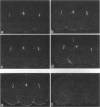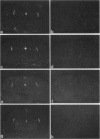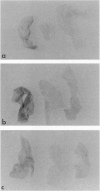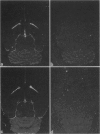Abstract
Binding studies were conducted to identify the anatomical location of brain target sites for OB protein, the ob gene product. 125I-labeled recombinant mouse OB protein or alkaline phosphatase-OB fusion proteins were used for in vitro and in vivo binding studies. Coronal brain sections or fresh tissue from lean, obese ob/ob, and obese db/db mice as well as lean and obese Zucker rats were probed to identify potential central OB protein-binding sites. We report here that recombinant OB protein binds specifically to the choroid plexus. The binding of OB protein (either radiolabeled or the alkaline phosphatase-OB fusion protein) and its displacement by unlabeled OB protein was similar in lean, obese ob/ob, and obese db/db mice as well as lean and obese Zucker rats. These findings suggest that OB protein binds with high affinity to a specific receptor in the choroid plexus. After binding to the choroid plexus receptor, OB protein may then be transported across the blood-brain barrier into the cerebrospinal fluid. Alternatively, binding of OB protein to a specific receptor in the choroid plexus may activate afferent neural inputs to the neural network that regulates feeding behavior and energy balance or may result in the clearance or degradation of OB protein. The identification of the choroid plexus as a brain binding site for OB protein will provide the basis for the construction of expression libraries and facilitate the rapid cloning of the choroid plexus OB receptor.
Full text
PDF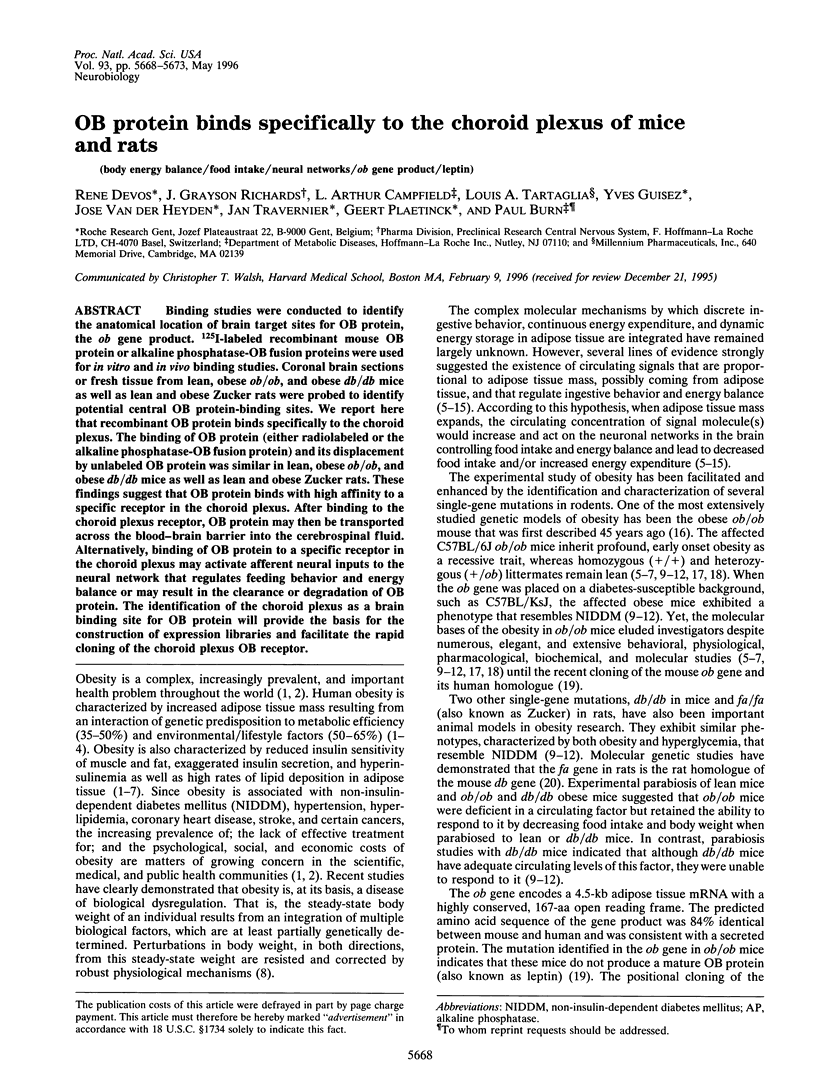
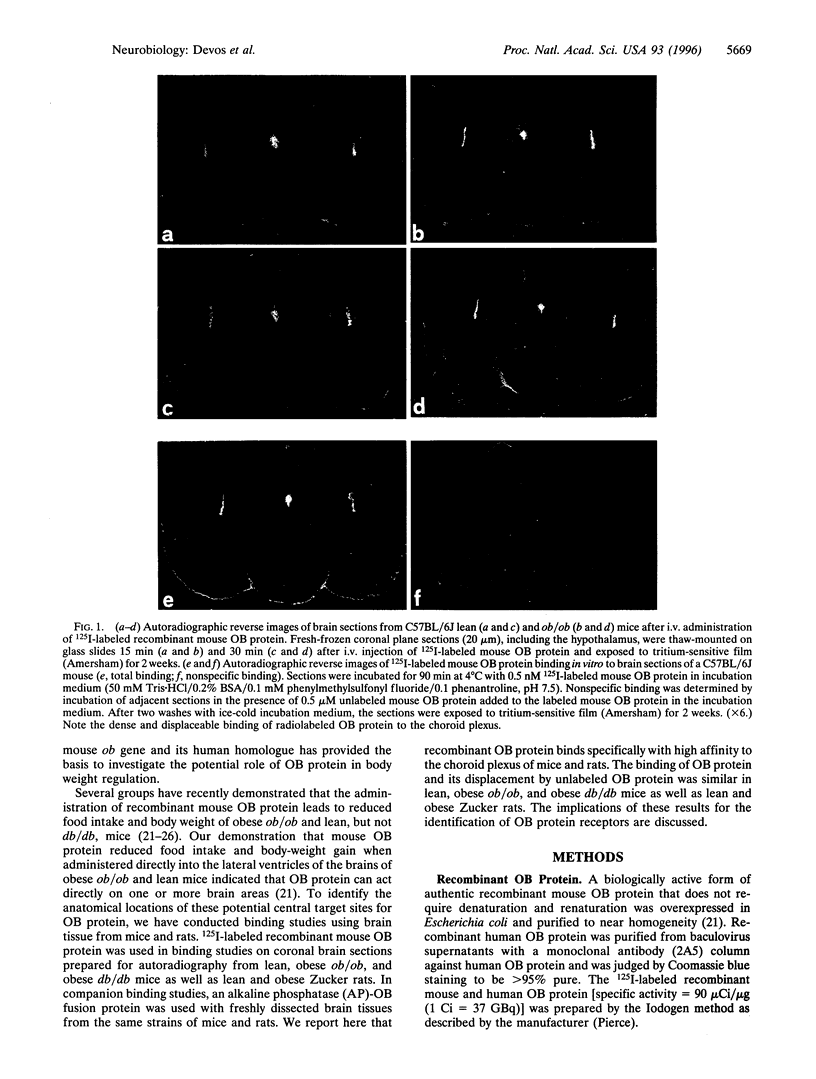
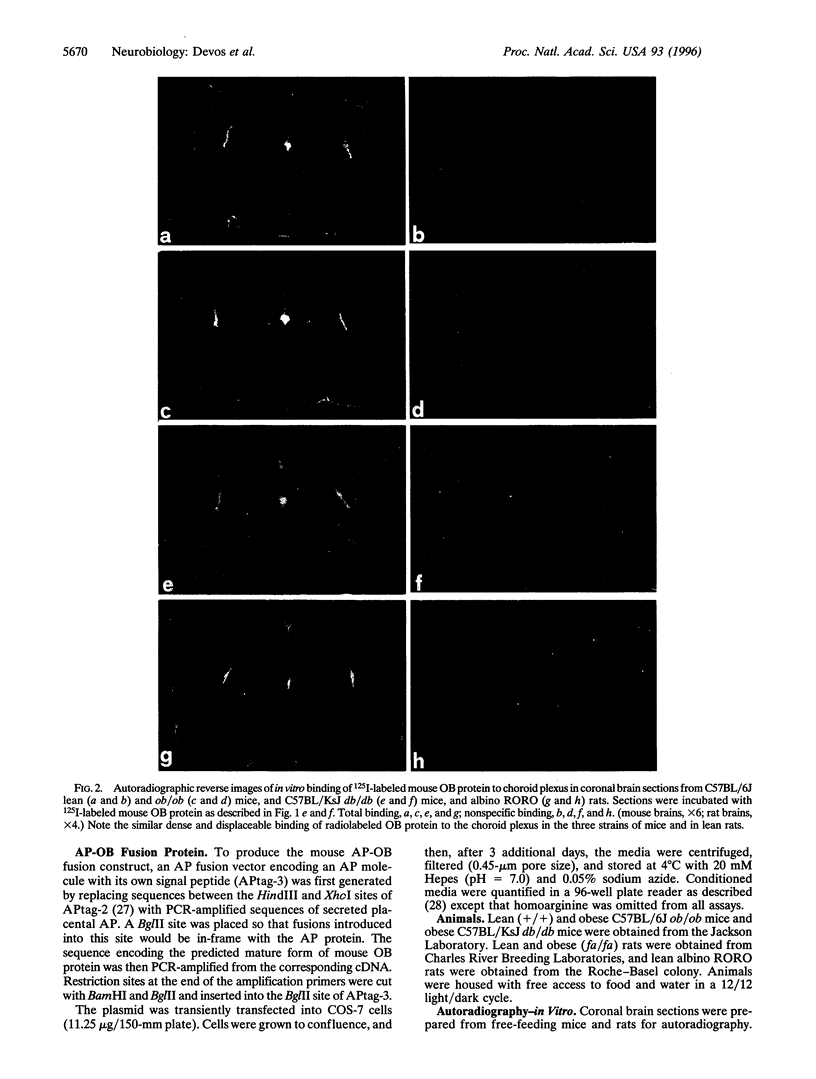
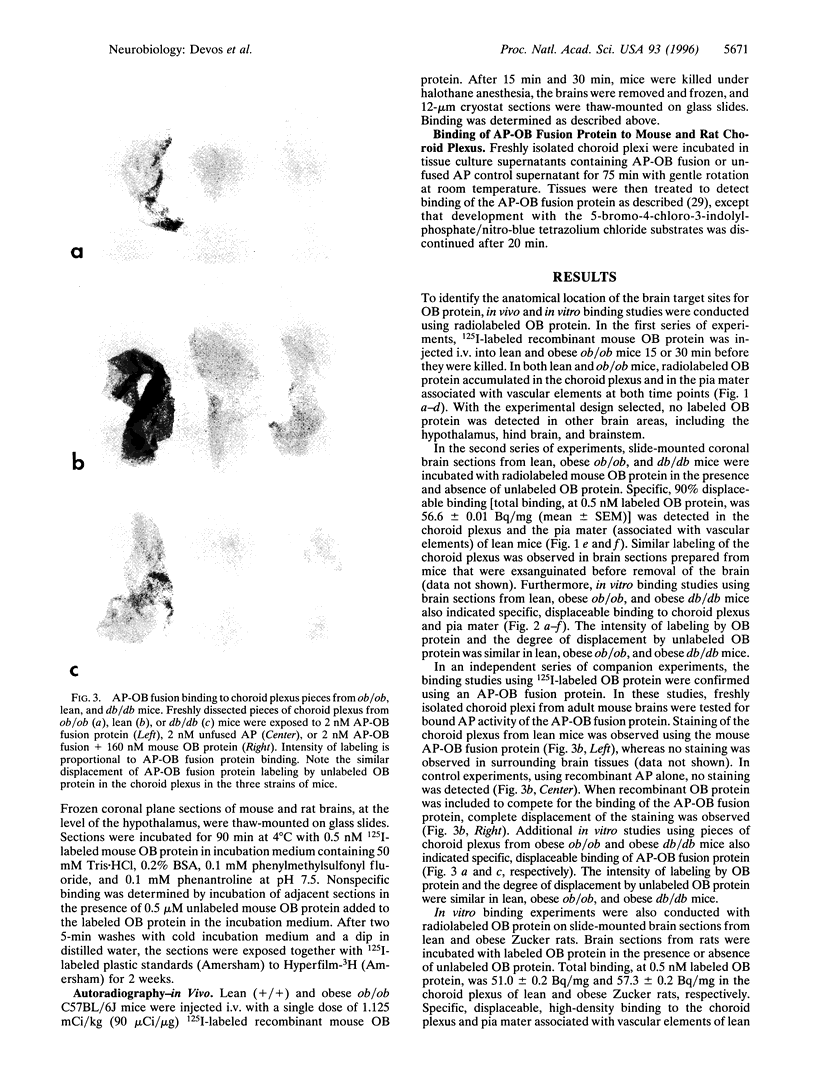
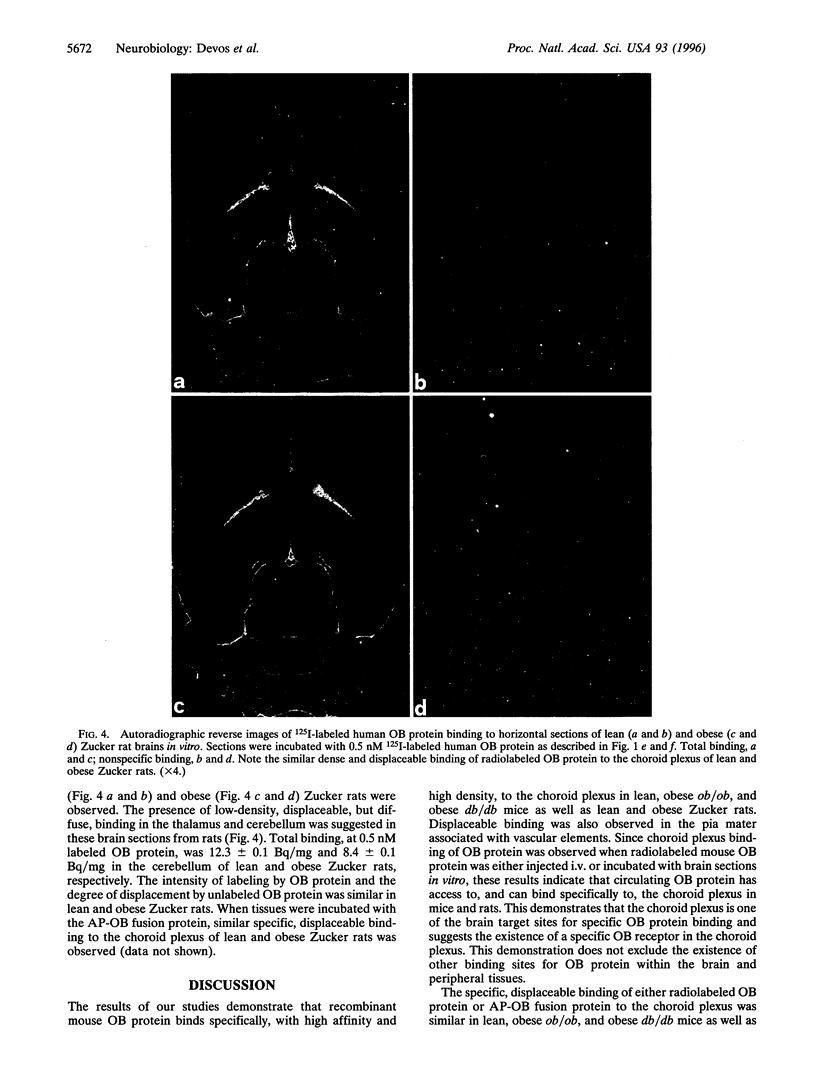

Images in this article
Selected References
These references are in PubMed. This may not be the complete list of references from this article.
- Bogardus C., Lillioja S., Ravussin E., Abbott W., Zawadzki J. K., Young A., Knowler W. C., Jacobowitz R., Moll P. P. Familial dependence of the resting metabolic rate. N Engl J Med. 1986 Jul 10;315(2):96–100. doi: 10.1056/NEJM198607103150205. [DOI] [PubMed] [Google Scholar]
- Bouchard C., Pérusse L. Genetics of obesity. Annu Rev Nutr. 1993;13:337–354. doi: 10.1146/annurev.nu.13.070193.002005. [DOI] [PubMed] [Google Scholar]
- Bray G. A., Campfield L. A. Metabolic factors in the control of energy stores. Metabolism. 1975 Jan;24(1):99–117. doi: 10.1016/0026-0495(75)90011-6. [DOI] [PubMed] [Google Scholar]
- Bray G. A., York D. A. Genetically transmitted obesity in rodents. Physiol Rev. 1971 Jul;51(3):598–646. doi: 10.1152/physrev.1971.51.3.598. [DOI] [PubMed] [Google Scholar]
- Bray G. A., York D. A. Hypothalamic and genetic obesity in experimental animals: an autonomic and endocrine hypothesis. Physiol Rev. 1979 Jul;59(3):719–809. doi: 10.1152/physrev.1979.59.3.719. [DOI] [PubMed] [Google Scholar]
- Campfield L. A., Smith F. J., Guisez Y., Devos R., Burn P. Recombinant mouse OB protein: evidence for a peripheral signal linking adiposity and central neural networks. Science. 1995 Jul 28;269(5223):546–549. doi: 10.1126/science.7624778. [DOI] [PubMed] [Google Scholar]
- Chen H., Charlat O., Tartaglia L. A., Woolf E. A., Weng X., Ellis S. J., Lakey N. D., Culpepper J., Moore K. J., Breitbart R. E. Evidence that the diabetes gene encodes the leptin receptor: identification of a mutation in the leptin receptor gene in db/db mice. Cell. 1996 Feb 9;84(3):491–495. doi: 10.1016/s0092-8674(00)81294-5. [DOI] [PubMed] [Google Scholar]
- Cheng H. J., Flanagan J. G. Identification and cloning of ELF-1, a developmentally expressed ligand for the Mek4 and Sek receptor tyrosine kinases. Cell. 1994 Oct 7;79(1):157–168. doi: 10.1016/0092-8674(94)90408-1. [DOI] [PubMed] [Google Scholar]
- Cheng H. J., Nakamoto M., Bergemann A. D., Flanagan J. G. Complementary gradients in expression and binding of ELF-1 and Mek4 in development of the topographic retinotectal projection map. Cell. 1995 Aug 11;82(3):371–381. doi: 10.1016/0092-8674(95)90426-3. [DOI] [PubMed] [Google Scholar]
- Coleman D. L. Effects of parabiosis of obese with diabetes and normal mice. Diabetologia. 1973 Aug;9(4):294–298. doi: 10.1007/BF01221857. [DOI] [PubMed] [Google Scholar]
- Coleman D. L., Hummel K. P. The influence of genetic background on the expression of the obese (Ob) gene in the mouse. Diabetologia. 1973 Aug;9(4):287–293. doi: 10.1007/BF01221856. [DOI] [PubMed] [Google Scholar]
- Coleman D. L. Inherited obesity-diabetes syndromes in the mouse. Prog Clin Biol Res. 1981;45:145–158. [PubMed] [Google Scholar]
- Davidson D. A., Bohannon N. J., Corp E. S., Lattemann D. P., Woods S. C., Porte D., Jr, Dorsa D. M., Baskin D. G. Evidence for separate receptors for insulin and insulin-like growth factor-I in choroid plexus of rat brain by quantitative autoradiography. J Histochem Cytochem. 1990 Sep;38(9):1289–1294. doi: 10.1177/38.9.2167329. [DOI] [PubMed] [Google Scholar]
- Flanagan J. G., Leder P. The kit ligand: a cell surface molecule altered in steel mutant fibroblasts. Cell. 1990 Oct 5;63(1):185–194. doi: 10.1016/0092-8674(90)90299-t. [DOI] [PubMed] [Google Scholar]
- Friedman J. M., Leibel R. L., Siegel D. S., Walsh J., Bahary N. Molecular mapping of the mouse ob mutation. Genomics. 1991 Dec;11(4):1054–1062. doi: 10.1016/0888-7543(91)90032-a. [DOI] [PubMed] [Google Scholar]
- Friedman J. M., Leibel R. L. Tackling a weighty problem. Cell. 1992 Apr 17;69(2):217–220. doi: 10.1016/0092-8674(92)90402-x. [DOI] [PubMed] [Google Scholar]
- Halaas J. L., Gajiwala K. S., Maffei M., Cohen S. L., Chait B. T., Rabinowitz D., Lallone R. L., Burley S. K., Friedman J. M. Weight-reducing effects of the plasma protein encoded by the obese gene. Science. 1995 Jul 28;269(5223):543–546. doi: 10.1126/science.7624777. [DOI] [PubMed] [Google Scholar]
- Herberg L., Coleman D. L. Laboratory animals exhibiting obesity and diabetes syndromes. Metabolism. 1977 Jan;26(1):59–99. doi: 10.1016/0026-0495(77)90128-7. [DOI] [PubMed] [Google Scholar]
- INGALLS A. M., DICKIE M. M., SNELL G. D. Obese, a new mutation in the house mouse. J Hered. 1950 Dec;41(12):317–318. doi: 10.1093/oxfordjournals.jhered.a106073. [DOI] [PubMed] [Google Scholar]
- KENNEDY G. C. The hypothalamic control of food intake in rats. Proc R Soc Lond B Biol Sci. 1950 Nov;137(889):535–549. doi: 10.1098/rspb.1950.0065. [DOI] [PubMed] [Google Scholar]
- Keesey R. E. Physiological regulation of body weight and the issue of obesity. Med Clin North Am. 1989 Jan;73(1):15–27. doi: 10.1016/s0025-7125(16)30689-7. [DOI] [PubMed] [Google Scholar]
- Leibel R. L., Rosenbaum M., Hirsch J. Changes in energy expenditure resulting from altered body weight. N Engl J Med. 1995 Mar 9;332(10):621–628. doi: 10.1056/NEJM199503093321001. [DOI] [PubMed] [Google Scholar]
- Pelleymounter M. A., Cullen M. J., Baker M. B., Hecht R., Winters D., Boone T., Collins F. Effects of the obese gene product on body weight regulation in ob/ob mice. Science. 1995 Jul 28;269(5223):540–543. doi: 10.1126/science.7624776. [DOI] [PubMed] [Google Scholar]
- Rentsch J., Levens N., Chiesi M. Recombinant ob-gene product reduces food intake in fasted mice. Biochem Biophys Res Commun. 1995 Sep 5;214(1):131–136. doi: 10.1006/bbrc.1995.2266. [DOI] [PubMed] [Google Scholar]
- Schwartz M. W., Figlewicz D. P., Baskin D. G., Woods S. C., Porte D., Jr Insulin in the brain: a hormonal regulator of energy balance. Endocr Rev. 1992 Aug;13(3):387–414. doi: 10.1210/edrv-13-3-387. [DOI] [PubMed] [Google Scholar]
- Stephens T. W., Basinski M., Bristow P. K., Bue-Valleskey J. M., Burgett S. G., Craft L., Hale J., Hoffmann J., Hsiung H. M., Kriauciunas A. The role of neuropeptide Y in the antiobesity action of the obese gene product. Nature. 1995 Oct 12;377(6549):530–532. doi: 10.1038/377530a0. [DOI] [PubMed] [Google Scholar]
- Tartaglia L. A., Dembski M., Weng X., Deng N., Culpepper J., Devos R., Richards G. J., Campfield L. A., Clark F. T., Deeds J. Identification and expression cloning of a leptin receptor, OB-R. Cell. 1995 Dec 29;83(7):1263–1271. doi: 10.1016/0092-8674(95)90151-5. [DOI] [PubMed] [Google Scholar]
- Truett G. E., Bahary N., Friedman J. M., Leibel R. L. Rat obesity gene fatty (fa) maps to chromosome 5: evidence for homology with the mouse gene diabetes (db). Proc Natl Acad Sci U S A. 1991 Sep 1;88(17):7806–7809. doi: 10.1073/pnas.88.17.7806. [DOI] [PMC free article] [PubMed] [Google Scholar]
- Weigle D. S., Bukowski T. R., Foster D. C., Holderman S., Kramer J. M., Lasser G., Lofton-Day C. E., Prunkard D. E., Raymond C., Kuijper J. L. Recombinant ob protein reduces feeding and body weight in the ob/ob mouse. J Clin Invest. 1995 Oct;96(4):2065–2070. doi: 10.1172/JCI118254. [DOI] [PMC free article] [PubMed] [Google Scholar]
- Zhang Y., Proenca R., Maffei M., Barone M., Leopold L., Friedman J. M. Positional cloning of the mouse obese gene and its human homologue. Nature. 1994 Dec 1;372(6505):425–432. doi: 10.1038/372425a0. [DOI] [PubMed] [Google Scholar]



